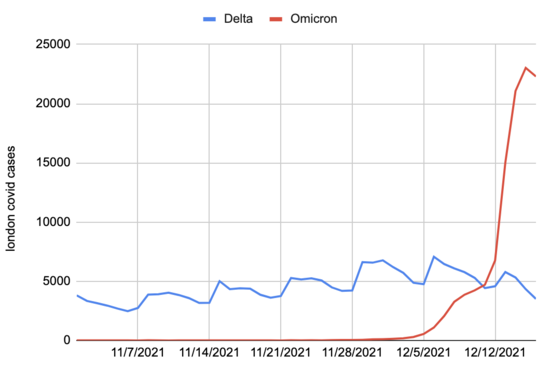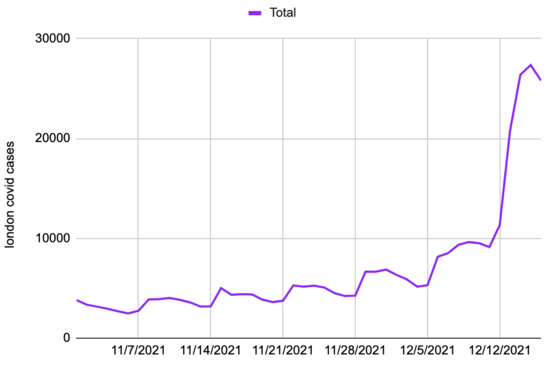Omicron Paths |
December 20th, 2021 |
| covid-19 |
Here's what cases look like in London:
London cases from coronavirus.data.gov.uk split by SGTF percentages from the Omicron daily overview. Inspired by Theo Sanderson's chart.
Now imagine that instead of seeing nice colored lines, you just saw a single line representing overall cases:
Instead of the rise in cases being apparent in the data from ~2021-12-01, it's not until ~2021-12-12 that we see it.
This is what the statistics will look like in places that don't know which cases are Omicron. It will look relatively flat, a small uptick which might be noise, and then a huge spike. And due to reporting delays, we won't see the spike until cases are much higher.
The biggest question in my mind is how we are going to react. Are we, as a society, going to seriously attempt to limit spread?
One potential path is that we don't. Vaccinated adults are in good shape, unvaccinated adults less so. Unvaccinated children were at a similar risk to vaccinated adults pre-Omicron. We don't shut things down and it burns through quickly. Hospitals probably get overloaded leading to additional deaths, especially of unvaccinated people.
Another potential path is that we really try: we go back to early 2020 policies, but at least this time we know to focus on air and not surfaces. Omicron is so infectious that I don't see how we contain it, and everyone still gets it eventually, but we have more time. This is the standard flattened curve, with fewer deaths due to the hospitals being less burdened, and the added potential benefit of Paxlovid approval (incredibly frustrating that it's still not even approved for emergency use) and scale up.
There are also paths in the middle, some of which makes sense. Every activity has some level of risk and some level of benefit, and the more we are able to move away from the ones with a bad ratio. The more we can gain time without giving up too much. In practice, however, I'm quite skeptical of this: our prioritization so far has been quite poor (indoor dining + remote elementary school!?) and while I would love to see improvement here, I'm not hopeful.
The White House is indicating pretty strongly that they're going for the first approach:
Our vaccines work against Omicron, especially for people who get booster shots when they are eligible. If you are vaccinated, you could test positive. But if you do get COVID, your case will likely be asymptomatic or mild.
We are intent on not letting Omicron disrupt work and school for the vaccinated. You've done the right thing, and we will get through this.
For the unvaccinated, you're looking at a winter of severe illness and death for yourselves, your families, and the hospitals you may soon overwhelm.
I think this last bit is an exaggeration: a large portion of unvaccinated people have already had covid. I'm also very interested in whether they will stick to this when cases start to skyrocket.
In terms of where this puts us as individuals, I think we also need to decide: how much are we willing to give up to avoid (or, more likely, postpone) catching Omicron? Getting a booster, if you haven't already, is worth it under a wide range of futures. The same goes for using good masks: cloth masks were a temporary stopgap while we scaled up production of better ones. N95s (and KN95s, KF94s, FFP2s, etc) all provide much better protection and are widely available, and even surgical masks are better than cloth.
Personally, I think gathering with vaccinated relatives and friends over the holidays is still worth it. There is some risk, including the risk that Omicron is already widespread here and we just don't know it yet, but the danger post-booster is low. I do recommend thinking through precautions and talking about them as a family: my extended family is planning to use rapid tests, air purifiers, and masks. We need to consider both sides of the balance, not just the increasingly large chance of an increasingly small harm, but also the value of seeing loved ones.
Comment via: facebook, lesswrong, substack

